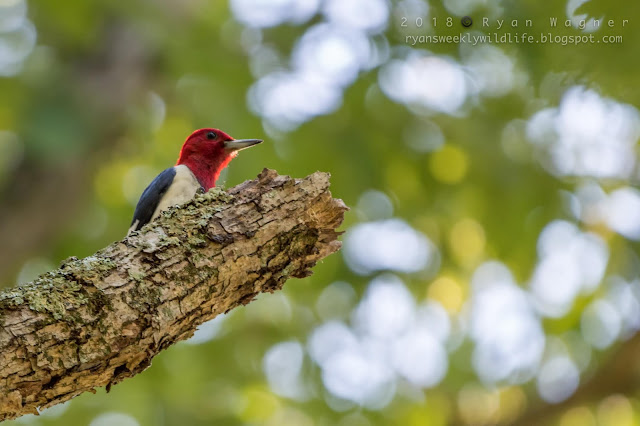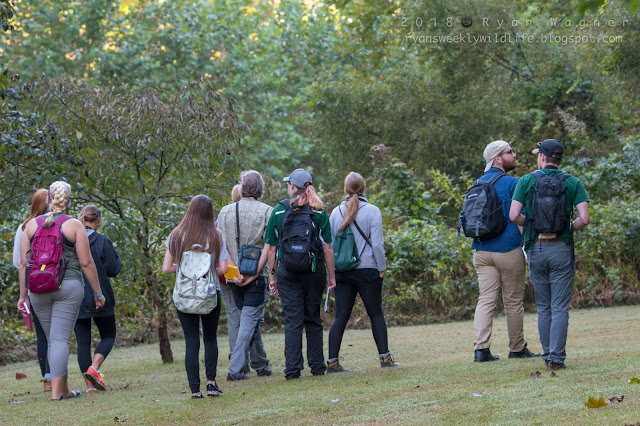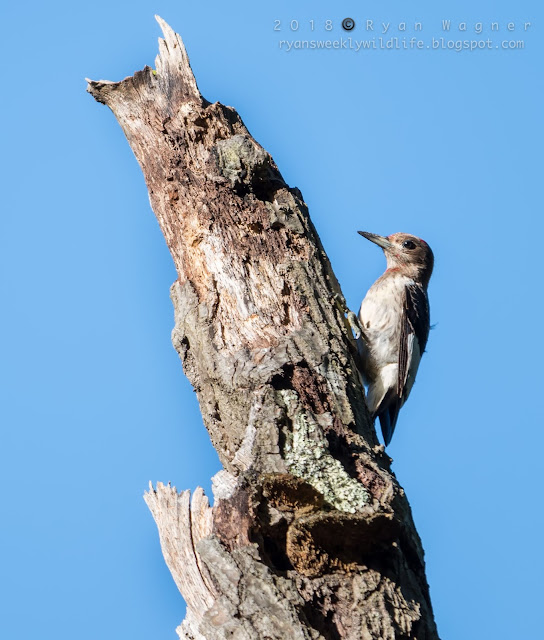This is the first installment in a blog series chronicling my
adventures in ornithology class. I’ve anticipated
taking this course ever since I first began attending Ohio University over 2
years ago. As a Wildlife Biology and
Conservation major, the famed “ologies,” ornithology, ichthyology, herpetology,
mammalogy, and entomology (birds, fish, reptiles, amphibians, mammals, and
insects respectively), are the basic tenets of any wildlife biologist. It has been a long road to get here, but
after countless hours in chemistry and physics labs, I finally get to leave the
classroom and venture into the outdoors.
To become a biologist, you must get your hands dirty.
It is 7 am. The sun
has just begun to rise, and I can already tell the cool morning will not last
long. This September has been exceedingly
hot, reaching the low 90s for days on end. If it warms too quickly, the bird won't remain active. Our small class of fledgling ornithologists files groggily into the bios
vans. I’ve spent a disproportionate
amount of my undergraduate career in these two timeworn vehicles. As I’ve mentioned before, I am prone to
motion sickness, and it’s safe to say these relics are an unforgiving pair. With a few morning donuts sitting heavily in
our stomachs, we set off to Zaleski State Forest.
I’ve visited Zaleski (or Lake Hope as it is sometimes
called) several times before. It hosts a
wide diversity of bird life as well as herpetofauna and a large (though
secretive) population of bobcats. We
park the vans near the old brick furnace, grab binoculars, and step out into
the morning air. Our professor, Dr. Don Miles, immediately begins spouting out the names of birds. “There go 2 mourning doves, brown thrasher in
that tree, blue jays, downy woodpecker, northern cardinal.” I consider myself a birder, but I’m always dumbfounded when ornithologists can spot and ID the tiniest of birds from within
the dense tangles of underbrush. I crane
my neck, camera held aloft, trying to pick out some movement that might give
the birds’ position away.
A gray bird zips onto a branch above me and begins bobbing its
tail—it’s an eastern phoebe. We would
see several more of these charismatic flycatchers during our hike. They are one of the easier birds to identify
simply because they perch in the open for extended periods of time (for birds
that means more than 2 seconds). Holly
Latteman, the TA, excitedly motions to the top of a tree. A yellow-billed cuckoo is hopping from branch
to branch, its long white and brown tail visible as it moves. Our group takes turns asking where the bird
is as we all scan the foliage. Luckily,
the cuckoo sticks around long enough for us all to spot it. I hear these birds much more often that I see
them; their cackling, knocking call is a common summertime sound in southern
Ohio.
As we hike towards a wetland, we catch a glimpse of a wood
duck uttering its whinnying call as it flushes.
Painted turtles and bullfrogs sit basking on tree stumps along the
shore. My friend Amanda Szinte points
out a green heron poised motionless on a log.
A kingfisher rattles past, flashing us with a streak of blue and
white. Chickadees dance overhead,
flipping upside down as they pluck seeds from the branches. A female pine warbler flutters across the pond
and a chestnut-sided warbler sings in the distance. Then we spot it, a woodpecker with a gray
head hitching its way up a dead white pine.
Variations in plumage between the sexes and age classes are one of the hardest
parts of bird identification. You could memorize an entire North American field guide and still be dumbfounded by this
gray-headed woodpecker.
Only six species of woodpecker frequent Ohio’s woodlands. Of them, the red-headed woodpecker might be the most stunning. It has a deep, blood-red head and neck, a white belly and a regal, black back with large, white wing patches. The attentive birder should listen for its call—a rapid, angry rattle—which often gives the bird’s location away. Despite the red head being the most defining characteristic of the adult bird, juvenile red-headed woodpeckers have totally gray heads. This is why it is imperative to know the entire life history of a species when trying to identify any bird. Telling apart all the female warblers or juvenile gulls is still something that keeps me up at night.
As we move further into the white pine forest we find ourselves surrounded by dozens of woodpeckers. Dr. Miles explains that the red-headed woodpecker is a relative of the acorn woodpecker, a western species famous for living in a life long family unit. Our red-headed woodpeckers appear to be several families with newly fledged young in the midst of a territorial dispute.
We walk along under the feuding families, red and black flashing overhead. Most of the birds we observe are juveniles. Their call is a weaker more strained version of the adults’. “They’re just learning to be woodpeckers,” Dr. Miles chuckles. A fitting first birding trip for our class of beginner birders. I look up at the gray-headed red-heads and smile as a young bird stashes an acorn in the wood of a dead tree.
Despite their abundance in Zaleski, the red-headed
woodpecker is listed as near threated by the IUCN Red List. Populations have declined by some 70% from
1966 to 2014. The felling of suitable dead
trees is thought to be linked to their decline.
It is positive to see the species maintaining a stronghold right here in
our own backyards. In October, our class
will be traveling down to South Carolina in search of an even rarer species of
woodpecker, the endangered red-cockaded woodpecker. With any luck we will find it and more.
Ryan









